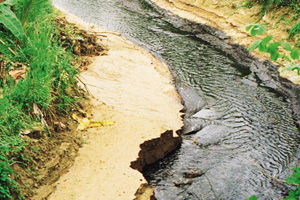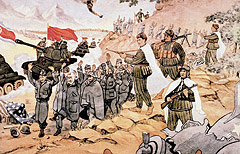Urban pollution
In cities, contamination is produced by the emission of toxic gasses, by the great production of household and industrial garbage, by sewer water, and other variables. All of these pollutants affect the atmosphere, the soil and the water.
Environment contamination or pollution is defined as the presence of foreign or harmful materials in the air or the increase in their concentrations. These are emitted in the form of gasses, or as miniscule solid particles.
All of these materials differ appreciably in the reaction and time of their active presence in the atmosphere, for which reason their impact on human health and ecosystems is quite varied.
Photochemical smog is a common phenomenon in several cities in the world, and is composed of harmful gasses such as tropospheric ozone or sulfur dioxide. These are produced when nitrogen oxides that are present in air come into contact with the sun’s rays. Nitrogen oxides – which in the atmosphere appear in the form of a dense layer similar to clouds – are substances emitted by vehicles, industries and to a lower degree by heating systems, all of which need oil and its derivatives (such as gasoline and paraffin) to function.
The components of photochemical smog cause numerous problems for the environment and for human health. Aside from contaminating the air, it causes damage to forest and agricultural zones close to cities, as well as to diverse animal species. As for the health problems referred to above, it causes serious respiratory problems such as bronchitis, asthma and pulmonary emphysema, especially affecting children and the elderly.
This kind of smog develops especially in cities with a lot of traffic, which are sunny and which have little air movement due to nearby mountainous zones. This is the case of the capital of Chile, Santiago.
This phenomenon is known as acid smog in winter, because the temperatures are much lower and the concentrations of sulfur dioxide rise because of the emissions of household central heating systems. In addition, ground temperature is sometimes less than that of the upper levels of the atmosphere, causing air to stay close to the ground, and with it the polluting elements.
Today, several measures are being taken to lower photochemical smog indexes in affected countries, such as reducing the circulation of vehicles, the use of catalytic converters in cars, and the use of clean energy (such as wind and solar energy), among others.
Another air pollutant is suspended dust, which consists of small particles of dust or sand that are lifted from the floor when swept, by air currents or vibrations, or by small explosions or fire. This phenomenon occurs especially in winter and it can be prevented by wetting the ground before sweeping, avoiding cutting trees, (as these capture suspended dust) and by not burning garbage.
Household waste or garbage (plastics, cardboard, paper, food scraps, and glass and metal containers) don’t just contaminate the city by accumulating and because many of their components are non-biodegradable (they take many years to decompose) but because they also significantly affect the air. This happens because by being together in garbage cans or rubbish dumps, they generate methane gas and filter percolated liquids (fluids that come from the rotting of organic material).
Also, studies show that rubbish dumps are sources of the proliferation of microorganisms, as garbage decomposes very little when very covered.
It’s also worthwhile to point out that garbage, and especially the filtration of percolated liquids, also pollutes soil and water (rivers, lakes and seas).
This situation increases on rainy days, as the waste is easily washed away. The substances that contain hydrocarbons appear in gaseous, liquid or solid forms. These particles are found in oil and its derivatives.
Plastics belong to the last category, non-biodegradable waste, which today is being recycled for use as a raw material in order to avoid its harmful effects.
The abuse of chemical products, such as aerosols, fertilizers and pesticides can cause environmental pollution and also poisons human beings.
Rural pollution
Human activities in the country have a great impact on nature, as they can cause damage to ecosystems and their biodiversity.
In this zone, pollution caused by the following agents is the most common:
– Pesticides: these are chemical substances that are used to kill or repel plagues or pests (insects, spiders, etc) but due to its permanence in the ground (even for several years) they can be harmful because they affect its natural composition. In addition, these chemicals can kill other organisms, deteriorating food chains or simply eliminating these species.
– Herbicides: these are chemical products which are used to kill weeds or undesirable plants in cultivated lands. These have an effect which is similar to that of pesticides, because they affect the ground, but in this case they can damage other species. For this reason they should be applied only in appropriate doses, covering the rest of the plants.
– Chemical fertilizers: plants make part of their food by extracting water from the ground and oxygen, hydrogen and carbon from the air, but to complement their food supply they need nutrients. Chemical (artificial) fertilizers increase the presence of these nutrients or add others so that plant species in cultivated lands develop optimally. However, excessive use can affect the ground, water and other plants.
– Deforestation: the reduction of forest caused by indiscriminate felling or excessive burning to obtain lands for agricultural cultivation brings with it an increase in CO2 levels in the atmosphere, as trees keep this compound in their fibers, and when they are cut, this gas is released into the air, contributing to the greenhouse effect. In addition, if trees or shrubs are burned they release extra quantities of CO2 into the air.
– Desertification: this is the continual degradation of dry lands as a result of man’s activities (over-pasturing, agricultural cultivation, deforestation, etc) and of climate variations (desert advance in drought seasons and its retreat in periods of abundant precipitations). One of the consequences is the increase in river and lake sedimentation.
– Erosion: wind and water pull fertile ground away from their place of origin, affecting other ecosystems that receive the foreign material. For example, sediments pushed towards the sea are deposited as residue and change the composition of the sea floor, burying caves.
It’s worthwhile to point out that soil erosion is accelerated by the destruction of the superficial level of the ground, as a result of poor cultivation techniques, over-pasturing, burning of vegetation and forest felling.
In this way, aside from erosion and the resulting sediments that are a product of soil degradation because of human activities, just the fact of losing fertile soils is alone a serious environmental problem, due to the fact that the affected zones and their biodiversity take time to regenerate themselves.
Eutrophication
This consists in an abnormal increase in the concentration of nutrients in a fresh water and coastal ecosystem. This causes the quota of oxygen present in water to decrease (hypoxia), or produces its total absence (anoxia) and as a result, aquatic species such as fish and mollusks die.
The compounds and elements that promote eutrophication are nitrates, phosphates, potassium (K), iron (Fe), sulfur (S), molybdenum (Mo), zinc (Zn) and magnesium (Mn).
These elements enter the water in the following ways:
1. Sewer water rich in organic material (excrement or food scraps, for example) and detergents from urban areas that arrive to rivers and seas.
2. Waste originating from industrial productive processes that flows into water courses or oceans.
3. Waste from agricultural fertilizers
4. Deforestation: when trees are eliminated, there are no roots to absorb water from soil. As a result, in place of entering the vascular system of tree species and being released into the atmosphere in the form of vapor, water accumulates in the soil and dilutes the nutrients it contains.
When water accumulates in excess, lixiviation increases, that is, a greater quantity of nutrients is pulled into river and lake water, increasing their concentration in these ecosystems.








 Termina la Guerra de Corea
Termina la Guerra de Corea